CM 681 LC Alloy Cannon-Muskegon developed CM 681 LC alloy for application as a high performance integral cast turbine wheel alloy. This alloy is an oxidation resistant alumina former, with relatively high Ta, low Ti, 3% Re and 1.5% Hf (Table 5). CM 681 LC was evaluated as part of an Advanced Materials for Small Turbine Engines (AMSTE) team NASA Aerospace Industry Technology Program (AITP) project which confirmed foundry performance in terms of low susceptibility to hot tearing/hot cracking and integral wheel quality assessment [21].
Typical room temperature tensile properties of CM 681 LC alloy vs. EQ MAR M 247 and EQ CM 247 LC alloys are provided in Table 6 demonstrating improved strength with good ductility. A comparison of CM 681 LC and MAR M 247 rupture life is shown in Figure 8.

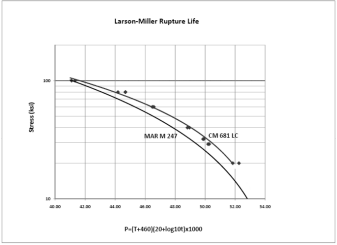 Figure 8 – CM 681 LC/MAR M 247 comparative Larson-Miller rupture life
Figure 8 – CM 681 LC/MAR M 247 comparative Larson-Miller rupture life
Applications developed or envisaged for CM 681 LC alloy include cost effective, high performance integral cast axial turbine wheels for cruise missile, UAV, and APU turbine engines, and microturbines for distributed power. Radial turbine wheel applications are also under development.
CM 186 LC Alloy
CM 186 LCâ is a Re-bearing DS alloy (Table 5) with mechanical properties close to those of first generation (non Re-bearing) SX superalloys. The excellent castability developed for DS CM 247 LC alloy was preserved and CM 186 LC alloy can be used in the as cast + double aged condition, reducing manufacturing costs and preventing the formation of solution heat treatment induced recrystallization (RX) defects [22].
As shown in Fig. 9, Larson-Miller rupture life of CM 186 LC alloy is equivalent to first generation SX alloys CMSX-2/3 under creep/stress-rupture test conditions which correspond to 982°C (1800°F). Strength at higher temperatures is intermediate between DS CM 247 LC and CMSX-2/3 [22].
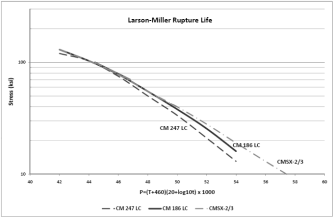 Figure 9 – Larson-Miller stress rupture life of DS CM 186 LC, DS CM 247 LC and SX CMSX-2/3
Figure 9 – Larson-Miller stress rupture life of DS CM 186 LC, DS CM 247 LC and SX CMSX-2/3
In recent years, the benefits of SX technology (enhanced component life due to superior fatigue, creep, oxidation and coating performance) have sometimes been offset by lower casting yields due to the complexity of casting features. Since all grain boundary strengthening elements have been eliminated, there is very little tolerance for casting anomalies, such as low and high angle boundaries (LAB/HAB). Typical SX castings limit LAB defects to 6-8.5° in the highest stressed locations of the castings.
DS Re-bearing alloys (such as CM 186 LC) have at times been used to replace first generation SX alloys (such as CMSX-2/3) at a cost savings due to higher casting yields [3]. However, DS components are less advantageous than SX vane castings due to grain boundaries in non-airfoil regions, particularly the inner and outer shrouds of multiple airfoil segments. Consequently, the concept to SX-cast CM 186 LC alloy to produce a single crystal casting with a more generous grain specification was evaluated with the intent of relaxing the grain requirements for higher casting yield [23]. This has been successfully implemented in the Rolls-Royce AE3007 and AE1107C Liberty 2nd vane segment with 35 million hours/flight cycle engine experience, with component lives typically 20,000 hours/cycles (Figure 10).
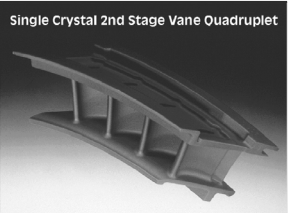 Figure 10 – AE 3007 A1 2nd vane segment cast in SX CM 186 LC alloy
Figure 10 – AE 3007 A1 2nd vane segment cast in SX CM 186 LC alloy
CMSX-4 Alloy
CMSX-4 is a second generation, Re-bearing nickel-base SX superalloy which has been extensively investigated and documented in the literature [4,5,22,24-25]. The nominal chemistry is provided in Table 5. CMSX-4 alloy has been successfully used in numerous aero and industrial gas turbine applications since 1991. These applications, such as high pressure turbine blades and seals, have demonstrated an impressive combination of high temperature strength, good phase stability and oxidation, hot corrosion and coating performance in extensive engine service [26-28]. Close to ten million pounds (1200 heats) of CMSX-4 alloy have been manufactured to date.
CMSX-4 [La+Y] alloy was subsequently introduced to meet ever-increasing engine design requirements for hot section turbine components. Of particular interest was improvement in bare alloy oxidation performance to minimize blade tip and internal oxidation and improve thermal barrier coating (TBC) adherence. Evaluation of reactive element additions demonstrated the oxidation behavior of bare CMSX-4 alloy (sulfur content £2 ppm) could be dramatically improved by the addition of lanthanum (La) and yttrium (Y) (Figure 11) [29]. These reactive elements tie up the sulfur and phosphorous as stable sulfides/phosphides which has a beneficial effect on the adherence of the alumina scale.
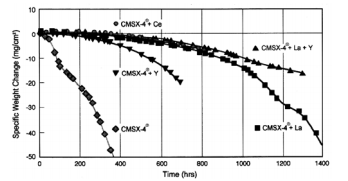
Figure 11 – 1093°C (2000°F) dynamic cyclic oxidation results for bare CMSX-4 alloywith and without reactive element additions
An example of the benefit of La + Y additions is shown in the remarkable surface microstructure observed following creep-rupture testing at 1050°C (1922°F) (Figure 12) [30]. After 1389 hours there was an 8 micron thick, 2-layer oxide film and no evidence of gamma prime depletion at all. Without the La+Y addition, significant g’ depletion would be expected from extended exposure at this temperature. This behavior translates to substantial improvement to EB-PVD TBC life, as demonstrated in Figure 13 [31].
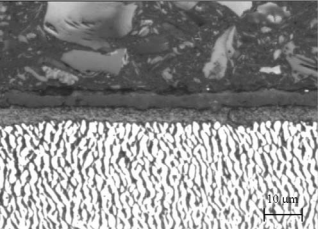 Figure 12 – Surface microstructure on CMSX-4 [39 ppm La+Y] followingcreep-rupture testing at 105°0C/125 MPa (courtesy Rolls-Royce plc)
Figure 12 – Surface microstructure on CMSX-4 [39 ppm La+Y] followingcreep-rupture testing at 105°0C/125 MPa (courtesy Rolls-Royce plc)
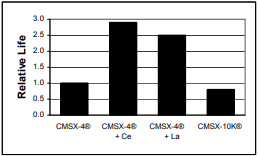 Figure 13 – Reactive element effects on EB-PVD TBC life1093°C/10 hr thermal exposure cycles (courtesy Solar® Turbines)
Figure 13 – Reactive element effects on EB-PVD TBC life1093°C/10 hr thermal exposure cycles (courtesy Solar® Turbines)

